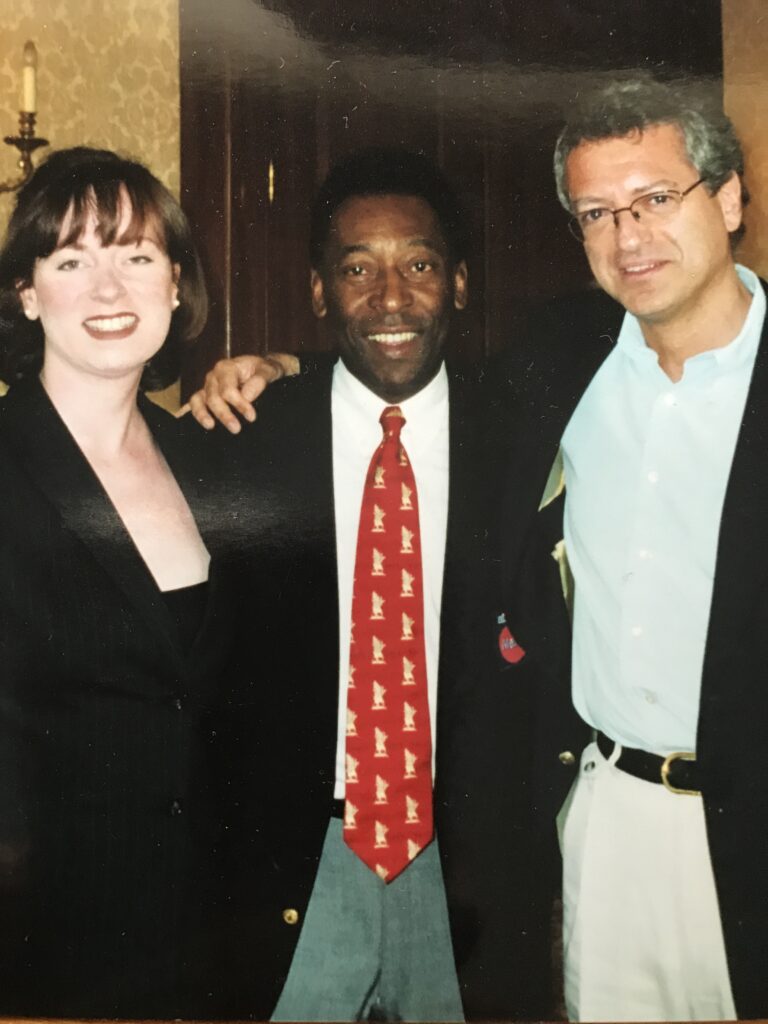Remembering Pelé: In conversation with Harry Harris
Seldom in history does an athlete arrive who defines not only the era that they compete in, but becomes a figurehead for virtually every other athlete irrespective of sporting discipline.
When one looks at era-defining athletes, Jesse Owens, Muhammad Ali, Johan Cruyff and Franz Beckenbauer spring to mind. But it wouldn’t be wrong to say that a certain Brazilian trumps every other sportsperson when it comes to influence and legacy.
Edson Arantes do Nascimento – more popularly known as Pelé around the world – is doubtlessly the greatest athlete to grace the sporting arena.
For context, he was declared Athlete of the Century by the International Olympic Committee (IOC) in 2000 even though he never featured at the Olympics.
Pelé surrounded by young fans
In addition, he also won the World Player of the Century accolade given by the International Federation of Football History and Statistics (IFFHS), and was the FIFA Player of the Century along with Diego Maradona.
As the world remembers Pelé on his 83rd birth anniversary, Sports Gazette brings forth some lesser-known facts about O Rei.
Pelé: Birth and early years
Pelé was born in October 1940 in the Três Corações municipality in Minas Gerais, Brazil. The former Santos player’s birthday is traditionally attributed to be 23rd October, but there is some debate about the actual birth date.
Multi-award winning football journalist Harry Harris, formerly Chief Football Writer at The Daily Mirror for 19 years, who has bylines in The Daily Express and The Daily Mail among others, and has authored the book Pelé: His Life and Times, provides more clarity on the matter.

Harris reveals that Pelé’s actual birth date is not 23rd October 1940, but two days before that.
“It’s just a story he told me when I was researching the book and speaking to him quite often about it.
“He was telling me the story about how he lived in quite a remote area, and it took two days to travel to the nearest main hospital to register his birth,” remarks Harris.
Pelé during a family meal with father Dondinho (left) and mother Dona Celeste (standing)
Harris also divulges how the boy Edson first came to be known as Pelé, albeit the nickname at that time carried some negative connotations.
“Children in his class, in his school used it almost as a derogatory term against him. I think mainly because of his height, because he was very small,” said Harris.
Pelé and Garrincha: The invincibles
Pelé and Garrincha were colleagues in the Brazil national team for almost a decade. And as per FIFA’s website, A Seleção never lost a game when both of these players were on the pitch.
They featured together for Brazil in 40 games, winning 36 and drawing 4, in an eight-year period which included three World Cup finals tournaments.
The mercurial duo’s last appearance together was in Brazil’s 1966 World Cup opener against Bulgaria.
Pelé (left) along with Garrincha in February 1968
Both of them scored via sumptuous free-kicks as A Seleção won 2-0 at Goodison Park, though none realised that the match would mark the end of their epoch together for Brazil.
Referring to Garrincha, Harris said “Many people in Brazil still revere him as even better than Pelé”.
Brazil, Pelé and la Copa América
Even though Pelé has three wins in four World Cup campaigns, he was never able to lift the South American Championship – or the Copa América (as it’s now called) – with Brazil during his career.
The talismanic Brazilian player’s only appearance in the continental showpiece was at the 1959 South American Championship held in Argentina. O Rei played spectacularly throughout the tournament, but Brazil missed being crowned continental champions by a solitary point.
Pelé scored eight goals in six matches, including a brace against Chile and a hat-trick against Paraguay.
According to Harry Harris, it was a case of the Brazilians prioritising the World Cup over the continental tournament.
Pelé looks at the Jules Rimet Trophy circa 1958
“There were a lot of South American teams that were exceptionally gifted and, I think for Brazil the World Cup was far more important,” he said.
Pelé: Legacy and life lessons
Along with being perhaps the greatest football player to ever step onto a football pitch, Pelé also taught everyone a plethora of life lessons. The most important among them being the quality of humility.
Pelé is lifted by supporters after the triumphant 1970 World Cup final
“He came from very humble beginnings and he never lost sight of those humble beginnings,” says Harris.
Another life lesson that Pelé taught everyone is having grit and determination in one’s life, no matter what one does.
“In life you pursue what you believe in, and I think Pelé was always single-minded, and I think he would have always pursued his football career.
“I don’t think he was ever going to be deterred,” remarks Harris.
What one can definitively say about O Rei is that he is one of the most successful and influential athletes in the history of all sport.
Pelé, with his imaginative skill and unwavering determination, came to define an era in sporting history that will, along with his memory, remain immortalised forever.